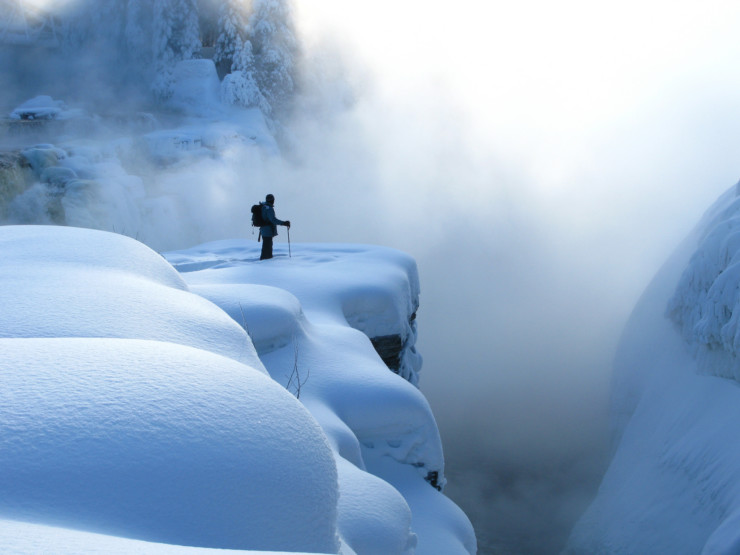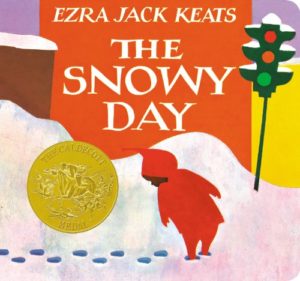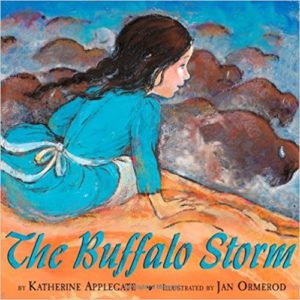
In college I took a children’s literature class. I wasn’t thinking about literacy for life, but I learned something I remembered ever since: I learned that children’s books have their own immortality.
One of our assignments was to take a picture book which had been in print for at least 25 years and talk about why we thought it had endured, using text and pictures. I chose The Snowy Day by Ezra Jack Keats. The book has now been in print for fifty-five years. In 1963, it won the Caldecott Medal, given to “the most distinguished American picture book for children.”
As a Central Texan, born and raised, I don’t see much snow. It still fascinates me. A book about a snowy day? With a little boy wearing a red snowsuit? Yes, please!
The snow on the cover — it’s not white. Or perhaps it started white but it now has pink and blue and green and purple splashes. This is city snow.
The Snowy Day is about a boy named Peter who wakes up on a winter morning and heads outside to play. This is a quiet book, the way the world is quiet when covered in new snow.
If this book were written in 2017, Peter would have exciting snow adventures, but here, he has quiet ones. He makes tracks in the snow, pointing his toes out and then in. He drags a stick and makes a track. He smacks a tree.
“Down fell the snow — plop! — on top of Peter’s head.”
The following page is just white snow, purple toe tracks, and Peter in his red snowsuit. No words.
I assume Peter is young because when he tries to join “the big boys” in a snowball fight, he ends up on the ground, with a snowball exploded on his chest.
“he knew he wasn’t old enough — not yet.”
Peter goes back to quiet snow play. He makes a snowman and angels. He climbs up and slides down. He pretends. He packs a snowball in his pocket to save for the next day (a plan which does not go well). Then he goes home to his mother. Peter and his mother are African American, a fact never stated but obvious in Keats’ illustrations. This story could be about any Peter of any race but it is about this Peter.
After his snowy day, Peter takes a bath and thinks. How often have you read a book in which the protagonist sits in a bubble bath, contemplating? Next we see a picture of Peter sleeping in bed. Bathing, thinking, sleeping — not riveting, right?
I can’t look away.
On the next page Peter dreams that the sun comes out and melts the snow, essentially the winter dream-come-true of every adult and the winter nightmare of every child. But when he wakes up, there is a brand new snowy day. And then something different happens.
“After breakfast he called to his friend from across the hall, and they went out together in the deep, deep snow.”
Peter’s friend was not present in the rest of the book, but now, he or she is there, dressed in a purple snowsuit. Now the snow looks different than anywhere else in the book. On top of the white background with splashes of color are pink, purple, and blue snowflakes. The snow has gone on its own journey through the book — from messy, to stark white, to a few bits of color, to a collage of wonder.
I think it’s no accident that this visual transformation happens in the presence of Peter’s friend. The snowball that he sneaked home in a pocket melted — he can never save that cold, round, firm loveliness. But a friend from across the hall? Well, he can keep a friend.
When I told my husband I would be writing this essay, I pulled out our board book of The Snowy Day, the one we read to the kids. He immediately started reading it aloud, and as soon as he said a line, I knew the next line that was coming. I could picture the illustrations before he turned the page. Unlike Peter’s snowball, this book never melts, not even on a hot summer day.
If we could see each other exactly as the other is, this would be a different world.”
—Ezra Jack Keats
New Book Club
Guess what? Here at Tweetspeak we’re starting our own children’s book club! It’s for grown-ups with childlike hearts or for grumpy grown-ups who need a little beauty and humor and poignancy in their worn-out world.
We’ll start on August 18 with The Buffalo Storm by Katherine Applegate, illustrated by Jan Ormerod. That should give you plenty of time to check it out from your library or find it at a used bookstore.
Take this post as a cue as you prepare. Read the words and look at the pictures. What do the pictures tell us that the words don’t? How do the words animate the pictures?
P.S. If you want to read more about Peter and watch him grow up, check out Whistle for Willie, Peter’s Chair, A Letter to Amy, Goggles!, Hi, Cat!, and Pet Show!. Ezra Jack Keats has many other wonderful picture books as well.
And you can stream a 40-minute animated version of The Snowy Day on Amazon Prime. In April it won two Emmys, one for Outstanding Preschool Children’s Animated Program and one for Outstanding Music Direction and Composition. (Boyz II Men, y’all!) This version is a holiday story. It is well done, but for me, nothing touches the brilliance of the original picture book.
Photo by Saguenay-Lac-Saint-Jean, Creative Commons, via Flickr. Post by Megan Willome, author of The Joy of Poetry.
Browse more Literacy Articles
- Perspective: The Two, The Only: Calvin and Hobbes - December 16, 2022
- Children’s Book Club: A Very Haunted Christmas - December 9, 2022
- By Heart: ‘The night is darkening round me’ by Emily Brontë - December 2, 2022


Donna says
This was always a favorite of mine- so hushed and sloppy and beautiful. I love how Keats teaches, through our attachment to that snowball via Peter, about impermanence- letting go – groundlessness. A child can grab their ‘experience,’ through the story, to help when the last cookie is unexpectedly gone, or the goldfish dies.
I’m excited about the new book club! What a happy surprise!!!! 🙂
Megan Willome says
I love your idea of impermanence here, Donna. And what a great application.
Hope you can join us for the book club!
Donna Falcone says
I’m so looking forward to it!
L.L. Barkat says
Just ordered from the library. I’m interested in Donna’s note about impermanence. 🙂
Also, I love listening to you talk about children’s books! So glad you’ll be doing that in a book club.
(Did you like any of the other Peter books as much as you liked this one?)
Donna Falcone says
🙂 I’m pretty sure I saw this last time I was in the Children’s library. I’ll go get it and definitely can’t wait for this book club to start, Megan!
As for impermanence…. ? Whatcha thinking, LL?
Megan Willome says
This one is my favorite because of the snow. They’re wonderful as a group, to show Peter and hia family and friends as they grow.
Callie Feyen says
I’ve always loved The Snowy Day. I loved any book that showed kids enjoying life in a city, and then, when I became a mother, and we lived in on a third floor condo building, I loved the book much more for reminding me that all sorts of wonderful adventures can still take place anywhere. Reading the book to my daughters, the three of us realized we could be just like Peter. Keats’ book sent me on a spree to look for more books that take place in cities, so I could show my children that there is so much to wonder about in all kinds of environments. I am quite thankful for The Snowy Day. Keats’ storytelling affirmed my delight in my Chicagoland childhood, and she reminded me of that when I became a mother years later.
Megan Willome says
What an interesting perspective, Callie. Let me know some of the city books you recommend.
Bethany R. says
Looking forward to this!
Megan Willome says
🙂
Andrea Culpepper says
Megan, I loved your pointing out that Peter didn’t do complicated things on his walk. I think the simplicity of his actions are calming to children, and perhaps one reason for its popularity. Kids can focus on Peter and the snow, and not worry about what he’s doing and if they could do it, also (emulation and comparison start early). And the fact he can’t really join in the snowball fight is okay… that day will come. What a gentle, affirming book. I didn’t read it to my kids much, but I think there’s a copy in my six large Rubbermaid Totes of my “favorite” children’s books. Thanks for sharing this.
Megan Willome says
Hi, Andrea! I like what you’re saying about how comparison starts early and how this book resists that. Glad to know there’s a copy in your Rubbermaid totes. It’s definitely a favorite of mine.
Katie says
Megan,
Thank you so much for this – enjoyed it immensely.
It set me on an hour plus long reverie reading EJK books:)
SO agree with his quote you gave at the bottom of your post.
Gratefully,
Katie
Megan Willome says
Thanks, Katie! And I’m so glad you enjoyed his quote. It’s on his website, http://www.ezra-jack-keats.org. I didn’t know there is an EJK award for authors and illustrators. Here’s a quote from the website about the judging criteria: “A distinguished selection committee of early childhood education specialists, librarians, illustrators and experts in children’s literature reviews the entries, seeking books that portray the universal qualities of childhood, a strong and supportive family, and the multicultural nature of our world. “
Sharon A Gibbs says
Oh, I hear the scrunching of boots in the snow (I am a Maine native). There is something very contemplative about being outside in the snow.
Children’s books have taken over most of my reading time these days! I love looking at their themes, layers, and patterns (thank you, L.L.) to find rich messages fitting for adults, too. Illustrations speak in their own special way, too.
So glad for this post, and the upcoming book club (I ordered “The Buffalo Storm” from my library).
Thank you, Megan!
Megan Willome says
Sharon, I am trusting that your picture book excursion will help us in our discussion next month. And I’m sure that as a Maine native you read about Peter’s snowy day differently than I do. You have meteorological insights I lack. 🙂
Sharon A Gibbs says
Megan,
I was unable to obtain a library copy of “The Snowy Day” in a timely manner but was able to view a YouTube reading of the book (complete with illustrations and sound effects!).
1. Did you notice the story’s bookends? Peter “woke up” and “had breakfast” in the beginning and the end.
2. There are a number of repetitions of three:
* “crunch, crunch, crunch”
* Peter made tracks pointing out, pointing in, and then dragged his feet slowly.
* He made a smiling snowman, made angels, and pretended he was a mountain-climber.
* He picked up a handful of snow, and another, and still another.
* He thought and thought and thought.
3. How many of us want to be like Peter?
Peter enjoys adventure, uses his imagination, wants to play with others, likes to save good things for later, and invites a friend.
Sounds like a formula for good living!
I’d love to hear what you and others have to say.
Megan Willome says
Observation 1: Did not see that at all. Not in all 100 or so times I’ve read this book. The idea of bookends for a children’s story is extremely attractive to me.
Observation 2: I think one of the reasons I love this book is the way it sounds, and that is all about the 3s. I could have repeated all of those lines to you without noticing they came in groups of three.
Observation 3: Yes! You are good at sum-ups, my friend.
Lane M Arnold says
A Children’s Book club for children of all ages….count me in! Can’t wait to join the fun.
Katie says
Count me in for the book club – sounds fun!